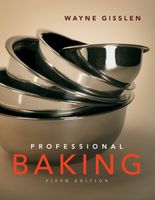Advertisement
Tools
Appears in
Published 2008
The following are needed for assembling and decorating cakes.
- Palette knife or steel spatula. A spatula with a long, flexible blade for spreading and smoothing icings and fillings.
Palette knife
- Offset palette knife. A palette knife with an angled blade that enables the chef to spread batters and creams inside pans.
Offset palette knife
- Serrated knife. A scalloped-edge knife for cutting cakes and for splitting cake layers horizontally into thinner layers.
Serrated knife
Icing screens or grates. Open-mesh screens for holding cakes being iced with a flow-type icing such as fondant. Excess icing drips off the cake and is collected on a tray under the rack.Icing screen
- Turntable. A pedestal with a flat, rotating top, which simplifies the job of icing cakes.
- Icing comb. A plastic triangle with toothed or serrated edges; used for applying a grooved or ridged pattern to the sides of iced cakes. The edge of the comb is held stationary in a vertical position against one side of the cake while the turntable is rotated.
- Plastic or steel scraper. The flat edge is easily used to make the icing on the sides of cake perfectly smooth. The technique is the same as the technique for using the icing comb.
- Brushes. Used to remove crumbs from a cake, to apply dessert syrups to sponge cake layers, and to glaze the surfaces of cakes with apricot glaze and other coatings.
Pastry brushes
- Sugar dredger. Looks like a large metal saltshaker. Used to dust cakes with confectioners’ sugar.
Sugar dredger
- Cake rings or charlotte rings. Stainless-steel rings of varying diameters and heights. Cakes are assembled inside these rings when they include soft fillings, such as Bavarian creams and other gelatin-based fillings, that must be held in place while the filling sets. Also used for charlottes (chapter 20).
- Cake cards and doilies. Layer cakes are placed on cardboard circles (same diameter as the cake) when being assembled. Sheet cakes are placed on half- or full-size cardboard cake boards. This makes them easy to ice and to move after icing. For easy, attractive display, place a paper doily 4 inches (10 cm) larger than the cake on a cake card 2 inches (5 cm) larger than the cake. For example, to assemble, ice, and display a 10-inch cake, use a 10-inch circle, a 12-inch circle, and a 14-inch doily.
- Parchment paper. For making paper cones.
- Pastry bag and tips. For making borders, inscriptions, flowers, and other designs out of icing. The basic tips are described.







